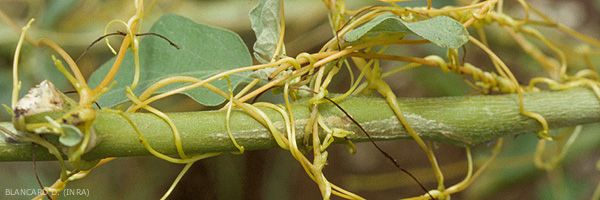
Cuscuta sp. (dodder)
The main species of dodder reported on tomato is Cuscuta pentagona Engelm (dodder fields) ( dodders ). Its dodder seeds can be stored for several years in the soil. After germinating on the surface or emerging from the ground, they give rise to rootless seedlings which will gradually cover the tomato through twining stems and parasitize its stems and leaves thanks to suckers, or haustoria. These allow them to access the vascular system of the tomato and thus to take the mineral elements, metabolites and water essential for their development, without having to resort to photosynthetic activities. Affected tomato plants have reduced growth, especially if they are parasitized early (Figure 1). In the latter case, they can die.
Dodders produce small flowers of variable color depending on the species (white, yellow, pink) gathered in glomeruli (figure 2). Countless seeds are produced, in the order of several thousand, which remain dormant in the soil for many years, sometimes more than 20 years. These are easily disseminated, like the majority of pathogens in the soil, by water, soil particles, machinery used for tillage, infested plants ...
Dodders produce small flowers of variable color depending on the species (white, yellow, pink) gathered in glomeruli (figure 2). Countless seeds are produced, in the order of several thousand, which remain dormant in the soil for many years, sometimes more than 20 years. These are easily disseminated, like the majority of pathogens in the soil, by water, soil particles, machinery used for tillage, infested plants ...
The control of these parasitic plants is particularly difficult due to the presence of numerous dormant seeds present in the soil and their broad host spectra. Among the vegetables, we can mention asparagus, beetroot, carrot, eggplant, asparagus, onion, melon, pepper, potato Several weeds can be parasitized ( Amaranthus sp., Chenopodium album , Convolvulus arvensis ). It is therefore necessary to implement in a complementary manner measures such as the application of long crop rotations with non-host plants (cereals, beans, cotton, maize, sorghum), the use of pre-emergence herbicides or of contact. Furthermore, seeds should not be introduced into a plot via irrigation water, in particular, seeds or plants. The first focus (s) observed must be destroyed as quickly as possible by burning the infested plants, preferably before flowering. It is desirable to plant tomatoes outside the periods of emergence of dodder seedlings. Tillage equipment, tools and workers' shoes must be cleaned after each intervention in an infested plot. Note that solarization would not completely eliminate the seeds of dodder present in the soil, composting seems to be more effective. Finally, several microorganisms are likely to infect dodder, including Alternaria alternata and Geotrichum candidum on Cuscuta pentagona . A few varieties of industrial tomatoes ('Heinz 9492', 'Heinz 9553' and 'Heinz 9992') have been shown to be tolerant to attack by this species. On these varieties, the first stages of the parasitic process of the dodder go well but, thereafter, many suckers formed seem unable to penetrate into the stems. Thus, the rate of parasitism is greatly reduced, as is the development of dodders.





